Exactly.rather unpractical
I was just referring to a "normal" condition in which not having to make any particular effort, if not those related to your audio system setup.
Last edited:
Out of curiosity, do you use it often?If I want to "play around" with the recorded stereo image, I use my SRS (Sound Retrieval System) which gives enhancement to the sound.
If affirmative - and if I may - when's the last time you used it, and why?
My three-way floorstanding speakers, with their tweeters at ear-level when seated, are placed and angled off their nearby walls in an unconventional way.Recently I simply angled the loudspeakers so that the axis of the tweers falls outside the imaginary midline that separates them and the stereo effect has dramatically increased and improved.
On an almost regular basis I've the compulsive impulse to modify in different way some element in my audio system hearing for any improvements, but that position of the speakers (which I have naturally marked on the floor) remains a fixed point.
I can't change that positioning and even if I do the result it is never better so far.
Also the "holographic" imaging has improved, with the perception of individual instruments or voices of singers who are more precisely and concretely positioned in their virtual space.
P. S.: I've not yet listened to an audio system that in a typical domestic room reproduces the recording of a musical event in a "real" way.
And IMO it's just here that the human auditive perception plays its role, because often even if a sound event is not reproduced in a "real" way it can be considered "realistic" and satisfy just enough to believe that one has well spent his money and his time and his commitment spent to achieve "the" purpose.
In addition, each speaker also has an additional tweeter mounted on its rear, also at ear-level.
That rear tweeter projects its sound off the rear walls near each speaker, at an angle.
This then disperses the highs in a broad way, which to me is quite pleasent.
If I turn on the SRS system to further expand the "sound stage", it gives the illusion that the walls of the room have dissapeared.
The "depth" of the effect is adjustable from mild, to simulating a concert hall's huge space.
Closing my eyes, and listening to some recordings, the singer, the instruments, seem to have "moved back" into a large imaginary space outside my living room, out into the garden.
It's very pleasing to me, and others who have stopped by to have a listen.
Most of the time I listen without the SRS system on, casual listening, like when cleaning the house, reading, etc.Out of curiosity, do you use it often?
If affirmative - and if I may - when's the last time you used it, and why?
But at times where I want to really "get into" the music/singing, I'll turn it on, relax on the sofa, and close my eyes.
Depending on the recording, which varies due to the way the sound engineer has handled his controls, some recordings actually amaze me with their "lifelike" depth and spaciousness.
For instance, a performance of some singers seem to come from outside the room, yet focused in a way that if I were blind, I'd swear they're 30 to 50 feet from me at a microphone on a stage in a large studio.
I have achieved that by making a mistake in the wiring.  It's documented somewhere here on the forum. Extremely wide and vivid image, some sounds outside the room/house, some even at the neighbor's house behind me. I had accidentally flipped polarity of one of the horns. Of course it killed center vocals, but the rest of the stuff was very cool. It's a lot of fun to play with, and I suppose part of the tricks used for virtual surround and effects like that.
It's documented somewhere here on the forum. Extremely wide and vivid image, some sounds outside the room/house, some even at the neighbor's house behind me. I had accidentally flipped polarity of one of the horns. Of course it killed center vocals, but the rest of the stuff was very cool. It's a lot of fun to play with, and I suppose part of the tricks used for virtual surround and effects like that.
For a couple of years I ran a Yamaha DSP-100 that was very good at pulling 4 ambient channels out of a stereo mix. Enjoyable but it didn't do anything for the center image or crosstalk, of course.
For a couple of years I ran a Yamaha DSP-100 that was very good at pulling 4 ambient channels out of a stereo mix. Enjoyable but it didn't do anything for the center image or crosstalk, of course.
Yes it should be, but I've never gotten it to work. Close, but never quite like the concert. At first I thought it was the recording medium - I started with DAT. But later I realized that a lot was missing in the recording that was not the fault of the medium. What was missing was a lot of direct sound, drums, guitar amps, some vocals, not to mention stage monitors. All those things go into what you hear live, and even though the PA is the largest part of that sound, enough of the other sounds get to your ear to make a difference. I suppose the larger the venue and the farther you are away, the less non-amplified sound matters, but it isn't as easy as you might think.It should be possible though rather unpractical for live recordings of rock concerts by using the same public address system as was used for the concert, at a similar volume, in an identical or at least similar room.
Well I have, many times. But mostly it was a rather large Hi-Fi system in a large room. Usually larger than a domestic setting. Also not having a direct A/B comparison to the real thing helps sustain the illusion.However, I've never listened an audio system able to play a rock concert recording, or a symphonic concert, or any other musical event that has only remotely approximate the "reality".
Strange enough, my loudspeakers correspond to your description...My three-way floorstanding speakers, with their tweeters at ear-level when seated, are placed and angled off their nearby walls in an unconventional way.
In addition, each speaker also has an additional tweeter mounted on its rear, also at ear-level.
Here they are.
However, after long tests and experiments I completely removed the switch related to the rear tweeter (when I modified the panel with the binding posts) to not have never again the temptation to use it.
At the end of the day I prefer without it.
I found interesting your experiments.
I have achieved that by making a mistake in the wiring.
. . . you could also achieve some unexpected success, some perhaps even by chance.
My speakers are the Avent Maestros, slightly modified (different 10" woofer), and the rear tweeter was added by me with it's own 2nd order crossover, and switched also, however it's never turned off, I enjoy the extra depth, sparkle, and how it makes the speakers seem to not be there.Strange enough, my loudspeakers correspond to your description...
Here they are.
However, after long tests and experiments I completely removed the switch related to the rear tweeter (when I modified the panel with the binding posts) to not have never again the temptation to use it.
At the end of the day I prefer without it.
I found interesting your experiments.
The tweeter I chose (back in 1995) is a cycolac horn compression tweeter.
Back in University (more years ago than I care to rememberUse headphones.
At the time some investigations about the "center of sound" appearing to move back behind your head when using headphones were being carried out.
We were demonstrated one of the experiments, where both filtering and added crosstalk was employed (maybe it is worth to mention that this was before DSP was available as it is today).
With some positive thinking
Recently I simply angled the loudspeakers so that the axis of the tweers falls outside the imaginary midline that separates them and the stereo effect has dramatically increased and improved.
This is an interesting and motivating finding. You modestly describe nothing but a very easy way to minimize xtalk a bit.
Think in an analogy to optics: With the beam of a flashlight, you can selectivly illuminate a single ear more than the other. And back to the stereo audio triangle, angling the speakers axis out to a certain point, will enlight the correct (L->L / R->R) ears more than the xtalking ears (L->R / R->L) . Like obturating the x-talk path also would do.
You will need a speaker with a well controlled and decently narrow horizontal directivity pattern in oder to work properly by simply angling out.
There is just one caveat with your method if applied to dipole speakers: Angling a dipole out will increase the signal intensity being reflected by the central parts of the front wall into you listening direction. This is why until now I had my Quad63 angled in by some 15° related to the triangle's side: To minimize the early front wall reflection. And honestly - I was not aware at all of the adverse effect on xtalk, which by angling in gets more intense.
Choose your evil, then. And thank you. I learned something.
Exactly.
I was just referring to a "normal" condition in which not having to make any particular effort, if not those related to your audio system setup.
As an aside, I went to see an outdoor concert of a punk rock band last Friday and listened to some of their songs at home later. I'm really happy it doesn't sound like the real thing when I listen at home. At the concert, I had to stand way in the back or use earplugs to get the sound down to a tolerable level, at home I can just set the volume control to a comfortable level
I know, but please note that I struggle to write in English - that is not my first language - and I use not only Google Translate, but also other translation sites (Reverso is very good for me) because I like to appropriately write.You modestly describe nothing
BUT, if what I would like to say has technical content, the "fatigue" becomes too much for me (and I would also employ too much time to write something) and therefore I tend to simplify the content very very much.
However, just to describe in other words what has already been said, one might say that my lodspeakers placement is so that the crossing point of the two frontal tweers is forwards (later, ahead) on my ears of about 50 cm, more or less.
Last edited:
Acute observation.As an aside, I went to see an outdoor concert of a punk rock band last Friday and listened to some of their songs at home later. I'm really happy it doesn't sound like the real thing when I listen at home. At the concert, I had to stand way in the back or use earplugs to get the sound down to a tolerable level, at home I can just set the volume control to a comfortable level
Or, when "realistic" is better than "reality"...
I have played with crosstalk cancelation a lot by DSP means. In general it is a good idea and works to extent that i don't like stereo without it. But as everything it is not perfect and you have to know:
1.
Binaural records are best for playback with crosstalk filter. Only in that case you get most natural image. But binaural records are almost non existent. Only ordinary stereo records. Stereo in some way are artificially created. So if ideal crosstalk canceler used(in example headphones) the sound is still not most natural. You can't get away with that. But if XTC(crosstalk cancelation) on loudspeakers for ordinary stereo it helps a little. Especially for center image. It is not perfect so there is no feel in head sound like with headhones, but center is a lot better. For side panned sounds is weird a little because you are trying to get sound from L speaker to L ear only. It is non existent situation in real life. And for non binaural records it is not perfect, but because filter is not perfect and because center image is better overall judging by my ear i use XTC for all ordinary stereo. For my own binaural records it is without any doubt XTC is preferred. More natural feel and image feels instantly.
2.
XTC filter has limitation of sweet spot vs frequency. And in reality it is very big limitation and for this and other reasons it is very difficult to do it good. I have tried all plugins i could get, but they showed some interesting features in sound but does't work at all for usable case. Usually they don't have HRTF implemented. I didn't test filter from Edgar Choueiri yet. These should be interesting to hear, but these are for closely spaced loudspeakers. I don't like this configuration. It provides better robustness for high frequency , because it is less sensitive for listener position. But at the same time it is less effective at lower frequencies. Because you have to boost more in order to cancel better. And energy in room doesn't disappear. You hear all reverberation field in the end and judge loudness. I do it for 60 degreee span louspeakers or more. For high frequencies head shadowing effect works better for higher span. So why not exploit that and use less crosstalk at high frequencies. I want to use XTC lower so i am not a fan off 5 degree spacing.Also for the reason that both speakers should be in front of you. Then probably is more sense to use one single speaker stereo configuration speaker in front of you. this paper also supports higher speaker separation https://pubs.aip.org/asa/jasa/artic...jective-and-subjective-analysis-of-effects-of
On the other hand Edgar Choueiri filter is here if you want to test and tell the opinion. jconvolver-1.1.0.tar.bz2 (381k). it is in xtalk-cancel folder. Info says that it is for 20degree speaker span. If it is true than it is not so narrow span. It is to use wih jack-audio and jconvolver.
3.
If you want to develop filter yourself i would suggest to limit frequency to 400hz-4khz for crosstalk. Use mid side decoding before. So you can use only for mid signal if you want. Use HRTF. For best results personalized HRTF prefered. Limit how much XTC is done especially for lower frequencies as the recursive tale will be long and all added things inevitably goes into room. Sooner or later it reaches you ear are you in sweet spot or not. So be careful.
If you have some specific questions you can write privately. I got tired to write this maybe call over Teams or something possible if the questions are not very basic
maybe call over Teams or something possible if the questions are not very basic
1.
Binaural records are best for playback with crosstalk filter. Only in that case you get most natural image. But binaural records are almost non existent. Only ordinary stereo records. Stereo in some way are artificially created. So if ideal crosstalk canceler used(in example headphones) the sound is still not most natural. You can't get away with that. But if XTC(crosstalk cancelation) on loudspeakers for ordinary stereo it helps a little. Especially for center image. It is not perfect so there is no feel in head sound like with headhones, but center is a lot better. For side panned sounds is weird a little because you are trying to get sound from L speaker to L ear only. It is non existent situation in real life. And for non binaural records it is not perfect, but because filter is not perfect and because center image is better overall judging by my ear i use XTC for all ordinary stereo. For my own binaural records it is without any doubt XTC is preferred. More natural feel and image feels instantly.
2.
XTC filter has limitation of sweet spot vs frequency. And in reality it is very big limitation and for this and other reasons it is very difficult to do it good. I have tried all plugins i could get, but they showed some interesting features in sound but does't work at all for usable case. Usually they don't have HRTF implemented. I didn't test filter from Edgar Choueiri yet. These should be interesting to hear, but these are for closely spaced loudspeakers. I don't like this configuration. It provides better robustness for high frequency , because it is less sensitive for listener position. But at the same time it is less effective at lower frequencies. Because you have to boost more in order to cancel better. And energy in room doesn't disappear. You hear all reverberation field in the end and judge loudness. I do it for 60 degreee span louspeakers or more. For high frequencies head shadowing effect works better for higher span. So why not exploit that and use less crosstalk at high frequencies. I want to use XTC lower so i am not a fan off 5 degree spacing.Also for the reason that both speakers should be in front of you. Then probably is more sense to use one single speaker stereo configuration speaker in front of you. this paper also supports higher speaker separation https://pubs.aip.org/asa/jasa/artic...jective-and-subjective-analysis-of-effects-of
On the other hand Edgar Choueiri filter is here if you want to test and tell the opinion. jconvolver-1.1.0.tar.bz2 (381k). it is in xtalk-cancel folder. Info says that it is for 20degree speaker span. If it is true than it is not so narrow span. It is to use wih jack-audio and jconvolver.
3.
If you want to develop filter yourself i would suggest to limit frequency to 400hz-4khz for crosstalk. Use mid side decoding before. So you can use only for mid signal if you want. Use HRTF. For best results personalized HRTF prefered. Limit how much XTC is done especially for lower frequencies as the recursive tale will be long and all added things inevitably goes into room. Sooner or later it reaches you ear are you in sweet spot or not. So be careful.
If you have some specific questions you can write privately. I got tired to write this
this paper also supports higher speaker separation https://pubs.aip.org/asa/jasa/artic...jective-and-subjective-analysis-of-effects-of
Very interesting paper which concludes the combination of Xtalk cancellation (XTC) along with a trinaural setup.
I really wonder how such a center-augmented system would perform in real life, as XTC alone with simple physical methods already does quite dramatically enhance the subjective stereo immersion. Try this one out yourself before theoretizizing about the need or about the needlessness of XTC: Listen first as usual. Then listen to you stereo along best with a acoustic absorbing PET felt board, or more handy a styropor blade, or large enough book aligned to you nose. As for my proper expierience with this quite silly yet effective setup, I was quite annoyed to realize that I would have to return to my "usual", non-XTC'd stereo setup for the moment. In an optical analogy: I felt a bit like closing one eye and thus loosing all the fascination of the stereo visual perception when I again took this sagittal board away.
A proper center sound source then added, as advocated in this funcamental paper, might further pinpoint central auditive events onto to theirs intended central location. I now think this is the way to go. XTC'd trinaural for best immersion.
It works !!! Finally !!!
After numerous (!) attempts I finally managed to cancel xtalk in a specific test setup to the extent that there was a max. 2dB deviation compared to switching the x-channel completely off. This for the good news. The bad news is that this very specific setup contained a vertikal, central tube of 50cm diameter, placed 35cm ahead of the microphone line. This quite huge tube then shaded the lower frequencies of the x-channel, which otherwise would be causing the first low-frequency notch. Then there was further up another notch, which could be flattended out by a 100% absorbtive, centrally (sagittally) placed wall between the microphone line and the tube. In german there is the saying "ein Brett vor dem Kopf haben". Which discribes a situation when you lack some clear view regarding the things around you happening ... I would say this wonderfully effective setup in terms of XTC also comes along with something like that "Brett", but more precisely as a "Röhre" instead. Anyone resorting to such a setup at home therefore inevitably might end having a "Röhre vor dem Kopf" altogether ...
Unfortunately, all other, domestically more tolerable setups were not very efficient in terms of wide-band XTC. My cherished playforms in the obturations zones of my initial drawings are all acoustically way too small to be effective. So, no acceptable XTC within an usual stereo setup. I am sorry for this regretful insight.
Let's look a bit into this iterative fun I had:
First, the effect of shifting the microphone to one side. Black is the fully symmetric placement, the mic is supposed to be placed at the mid of the head's location, the stereo sweetspot. Then the shift to the right side is performed by n samples delay between right and left channels arrival time.
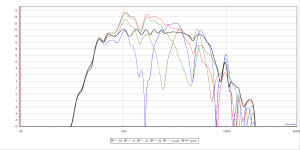
All further setups for XTC then were tested at a sample shift of 30 samples for the arrival times between L and R, corresponding to a lateral shift of some 11cm. So the blue line would more or less show the notching for a human head. First, three examples of shading, absorbing and deflecting by different means at different locations ...
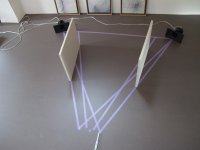
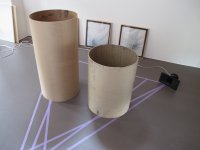
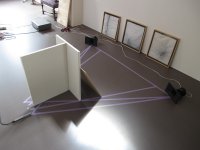
How does that measure?
First for vertical plates at different locations, more or less paced in a 90° ange related to the stereo base:
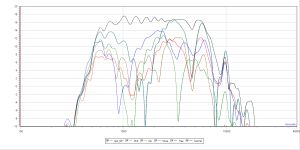
And then the outcome of different boards of more or less the same size, all used at the same location, e.g. in the plane of the nose placement:
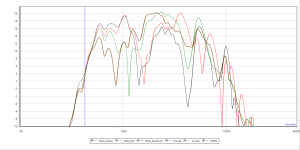
Deep notches everywhere, as signs of x-talk notching. So no real XTC effects along while using more or less acceptable structures. And then, in sheer despair, the final monster-tube-game-changer iteration(s):
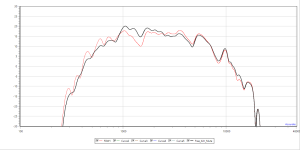
Black graph is no structures at all between mic and the stereo base, mic. offset by 30 samples. In order to simulate a no-x-talk situation the x-channel is muted.
Red graph is x-channel on, a tube at 33cm from the mic/ear baseline, and an additional sagittal absorber in the central plane.
Really and finally, a nice cancelling of the x-talk. No x-talk related notches means that there is nearly no x-talk. There were even some better variants, but which have not been documented. Best one, as mentionned before, was a 2dB match between black and red.
Did I hear someone say Big Is Beautiful?
After numerous (!) attempts I finally managed to cancel xtalk in a specific test setup to the extent that there was a max. 2dB deviation compared to switching the x-channel completely off. This for the good news. The bad news is that this very specific setup contained a vertikal, central tube of 50cm diameter, placed 35cm ahead of the microphone line. This quite huge tube then shaded the lower frequencies of the x-channel, which otherwise would be causing the first low-frequency notch. Then there was further up another notch, which could be flattended out by a 100% absorbtive, centrally (sagittally) placed wall between the microphone line and the tube. In german there is the saying "ein Brett vor dem Kopf haben". Which discribes a situation when you lack some clear view regarding the things around you happening ... I would say this wonderfully effective setup in terms of XTC also comes along with something like that "Brett", but more precisely as a "Röhre" instead. Anyone resorting to such a setup at home therefore inevitably might end having a "Röhre vor dem Kopf" altogether ...
Unfortunately, all other, domestically more tolerable setups were not very efficient in terms of wide-band XTC. My cherished playforms in the obturations zones of my initial drawings are all acoustically way too small to be effective. So, no acceptable XTC within an usual stereo setup. I am sorry for this regretful insight.
Let's look a bit into this iterative fun I had:
First, the effect of shifting the microphone to one side. Black is the fully symmetric placement, the mic is supposed to be placed at the mid of the head's location, the stereo sweetspot. Then the shift to the right side is performed by n samples delay between right and left channels arrival time.

All further setups for XTC then were tested at a sample shift of 30 samples for the arrival times between L and R, corresponding to a lateral shift of some 11cm. So the blue line would more or less show the notching for a human head. First, three examples of shading, absorbing and deflecting by different means at different locations ...



How does that measure?
First for vertical plates at different locations, more or less paced in a 90° ange related to the stereo base:

And then the outcome of different boards of more or less the same size, all used at the same location, e.g. in the plane of the nose placement:

Deep notches everywhere, as signs of x-talk notching. So no real XTC effects along while using more or less acceptable structures. And then, in sheer despair, the final monster-tube-game-changer iteration(s):

Black graph is no structures at all between mic and the stereo base, mic. offset by 30 samples. In order to simulate a no-x-talk situation the x-channel is muted.
Red graph is x-channel on, a tube at 33cm from the mic/ear baseline, and an additional sagittal absorber in the central plane.
Really and finally, a nice cancelling of the x-talk. No x-talk related notches means that there is nearly no x-talk. There were even some better variants, but which have not been documented. Best one, as mentionned before, was a 2dB match between black and red.
Did I hear someone say Big Is Beautiful?
Last edited:
don't understand the thing in measurements. What you measure and to what reference point? Without binaural head microphone i don't see how you can measure something meaningful. This is head and pinna shadowing effect for 30 degree sound arriving direction from 3m away. It is standart speaker placement. Accurate to about 8khz. Above 8khz just not sure about accuracy. This is what head shadowing provides naturally without any XTC.
With XTC we want this line lower as possible. I think this is what you want to measure to evaluate how good XTC is

With XTC we want this line lower as possible. I think this is what you want to measure to evaluate how good XTC is
The results of my own decades ago anecdotal experience with an experimental electronic-XTC circuit was exciting at first, but, ultimately it became an unwelcome listening distraction. The circuit was my own original design (as far as I know), based around a Bessel low-pass filter to produce the XTC delay. It was inspired by Joel Cohen's, of 'Sound Concepts', circa 1980 XTC circuit. Except that my design eliminated the need for the switched-capacitor bucket-brigade delay device in his circuit.
The subjective effect of XTC was quite pronounced. Expanding the stereo image-width to far beyond the loudspeaker position boundaries. Dramatically so on some recordings. It located some instruments to the upper corners of the room front, and sometimes beyond. Instruments seemed to emanate completely detached from the speakers. Since I'd never before experienced such an effect via 2-chan. stereo, it was indeed startling. While the effect seemed to expand the lateral width of soundstage, it didn't seem to expand the front-to-back image depth.
Ultimately, the effect subjectively became something of a Fun-House's Hall of Mirrors, or maybe a Surrealist painting. Creating what seemed to be an interesting, yet unnatural distortion of reality. It was entertaining, but not musically satisfying. I suspect that much of that unnatural spatial effect was due to my commercial release recordings not having been mixed with XTC in-mind. I didn't then have access to any binaural recordings to confirm that suspicion though.
The subjective effect of XTC was quite pronounced. Expanding the stereo image-width to far beyond the loudspeaker position boundaries. Dramatically so on some recordings. It located some instruments to the upper corners of the room front, and sometimes beyond. Instruments seemed to emanate completely detached from the speakers. Since I'd never before experienced such an effect via 2-chan. stereo, it was indeed startling. While the effect seemed to expand the lateral width of soundstage, it didn't seem to expand the front-to-back image depth.
Ultimately, the effect subjectively became something of a Fun-House's Hall of Mirrors, or maybe a Surrealist painting. Creating what seemed to be an interesting, yet unnatural distortion of reality. It was entertaining, but not musically satisfying. I suspect that much of that unnatural spatial effect was due to my commercial release recordings not having been mixed with XTC in-mind. I didn't then have access to any binaural recordings to confirm that suspicion though.
- Home
- General Interest
- Room Acoustics & Mods
- Stereo inter-ear crosstalk minimizing for typical stereo loudpeaker setups - can it work?